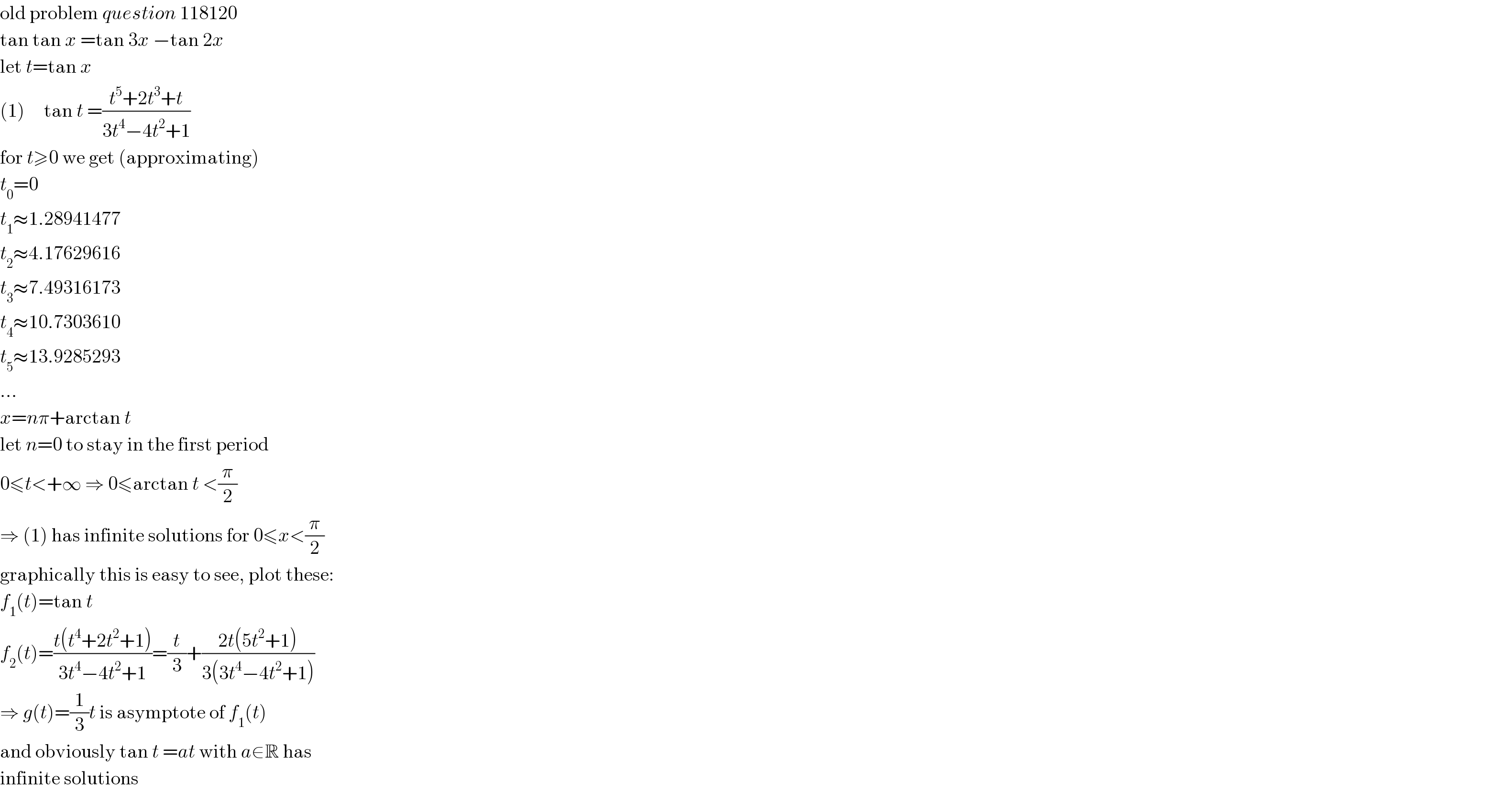Question Number 118371 by MJS_new last updated on 17/Oct/20

$$\mathrm{old}\:\mathrm{problem}\:{question}\:\mathrm{118120} \\ $$$$\mathrm{tan}\:\mathrm{tan}\:{x}\:=\mathrm{tan}\:\mathrm{3}{x}\:−\mathrm{tan}\:\mathrm{2}{x} \\ $$$$\mathrm{let}\:{t}=\mathrm{tan}\:{x} \\ $$$$\left(\mathrm{1}\right)\:\:\:\:\:\mathrm{tan}\:{t}\:=\frac{{t}^{\mathrm{5}} +\mathrm{2}{t}^{\mathrm{3}} +{t}}{\mathrm{3}{t}^{\mathrm{4}} −\mathrm{4}{t}^{\mathrm{2}} +\mathrm{1}} \\ $$$$\mathrm{for}\:{t}\geqslant\mathrm{0}\:\mathrm{we}\:\mathrm{get}\:\left(\mathrm{approximating}\right) \\ $$$${t}_{\mathrm{0}} =\mathrm{0} \\ $$$${t}_{\mathrm{1}} \approx\mathrm{1}.\mathrm{28941477} \\ $$$${t}_{\mathrm{2}} \approx\mathrm{4}.\mathrm{17629616} \\ $$$${t}_{\mathrm{3}} \approx\mathrm{7}.\mathrm{49316173} \\ $$$${t}_{\mathrm{4}} \approx\mathrm{10}.\mathrm{7303610} \\ $$$${t}_{\mathrm{5}} \approx\mathrm{13}.\mathrm{9285293} \\ $$$$… \\ $$$${x}={n}\pi+\mathrm{arctan}\:{t} \\ $$$$\mathrm{let}\:{n}=\mathrm{0}\:\mathrm{to}\:\mathrm{stay}\:\mathrm{in}\:\mathrm{the}\:\mathrm{first}\:\mathrm{period} \\ $$$$\mathrm{0}\leqslant{t}<+\infty\:\Rightarrow\:\mathrm{0}\leqslant\mathrm{arctan}\:{t}\:<\frac{\pi}{\mathrm{2}} \\ $$$$\Rightarrow\:\left(\mathrm{1}\right)\:\mathrm{has}\:\mathrm{infinite}\:\mathrm{solutions}\:\mathrm{for}\:\mathrm{0}\leqslant{x}<\frac{\pi}{\mathrm{2}} \\ $$$$\mathrm{graphically}\:\mathrm{this}\:\mathrm{is}\:\mathrm{easy}\:\mathrm{to}\:\mathrm{see},\:\mathrm{plot}\:\mathrm{these}: \\ $$$${f}_{\mathrm{1}} \left({t}\right)=\mathrm{tan}\:{t} \\ $$$${f}_{\mathrm{2}} \left({t}\right)=\frac{{t}\left({t}^{\mathrm{4}} +\mathrm{2}{t}^{\mathrm{2}} +\mathrm{1}\right)}{\mathrm{3}{t}^{\mathrm{4}} −\mathrm{4}{t}^{\mathrm{2}} +\mathrm{1}}=\frac{{t}}{\mathrm{3}}+\frac{\mathrm{2}{t}\left(\mathrm{5}{t}^{\mathrm{2}} +\mathrm{1}\right)}{\mathrm{3}\left(\mathrm{3}{t}^{\mathrm{4}} −\mathrm{4}{t}^{\mathrm{2}} +\mathrm{1}\right)} \\ $$$$\Rightarrow\:{g}\left({t}\right)=\frac{\mathrm{1}}{\mathrm{3}}{t}\:\mathrm{is}\:\mathrm{asymptote}\:\mathrm{of}\:{f}_{\mathrm{1}} \left({t}\right) \\ $$$$\mathrm{and}\:\mathrm{obviously}\:\mathrm{tan}\:{t}\:={at}\:\mathrm{with}\:{a}\in\mathbb{R}\:\mathrm{has} \\ $$$$\mathrm{infinite}\:\mathrm{solutions} \\ $$
Commented by prakash jain last updated on 17/Oct/20

$$\mathrm{Agree}.\:\mathrm{There}\:\mathrm{were}\:\mathrm{mistakes}\:\mathrm{in} \\ $$$$\mathrm{my}\:\mathrm{previous}\:\mathrm{calculation}. \\ $$
